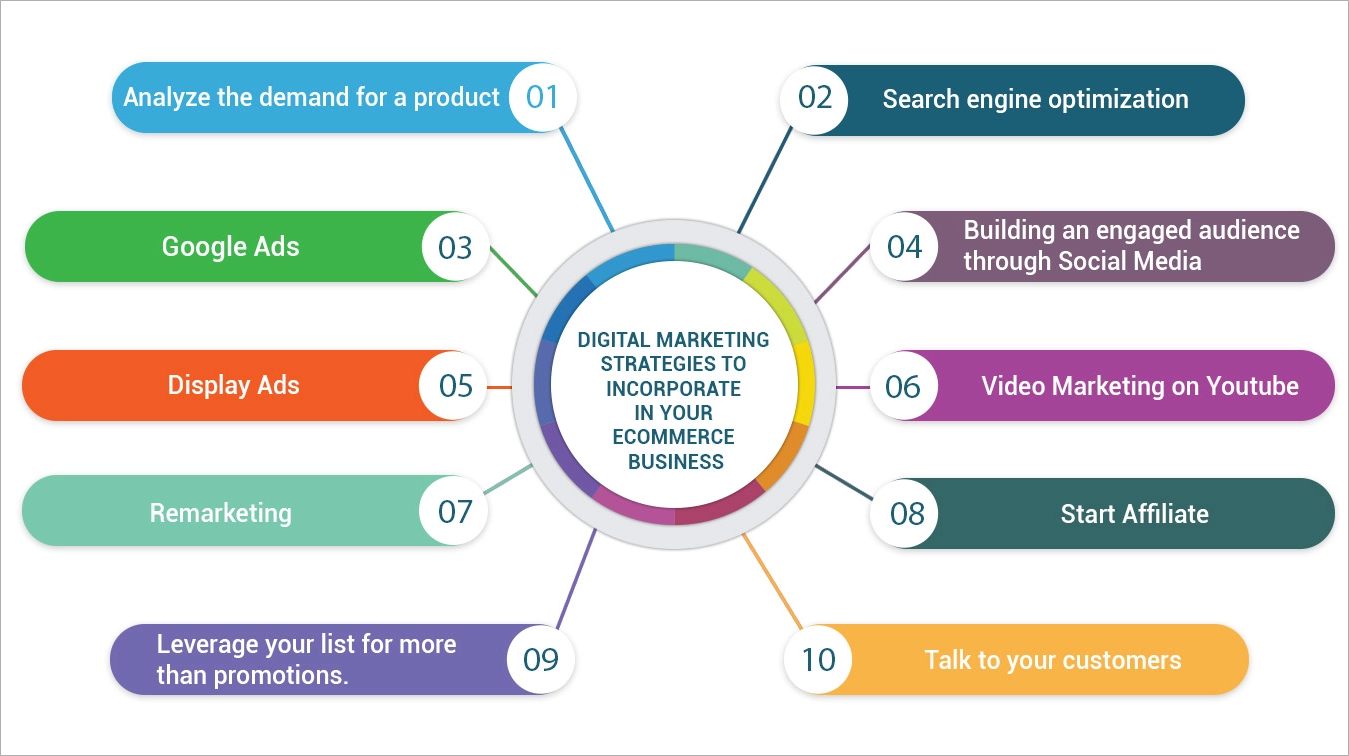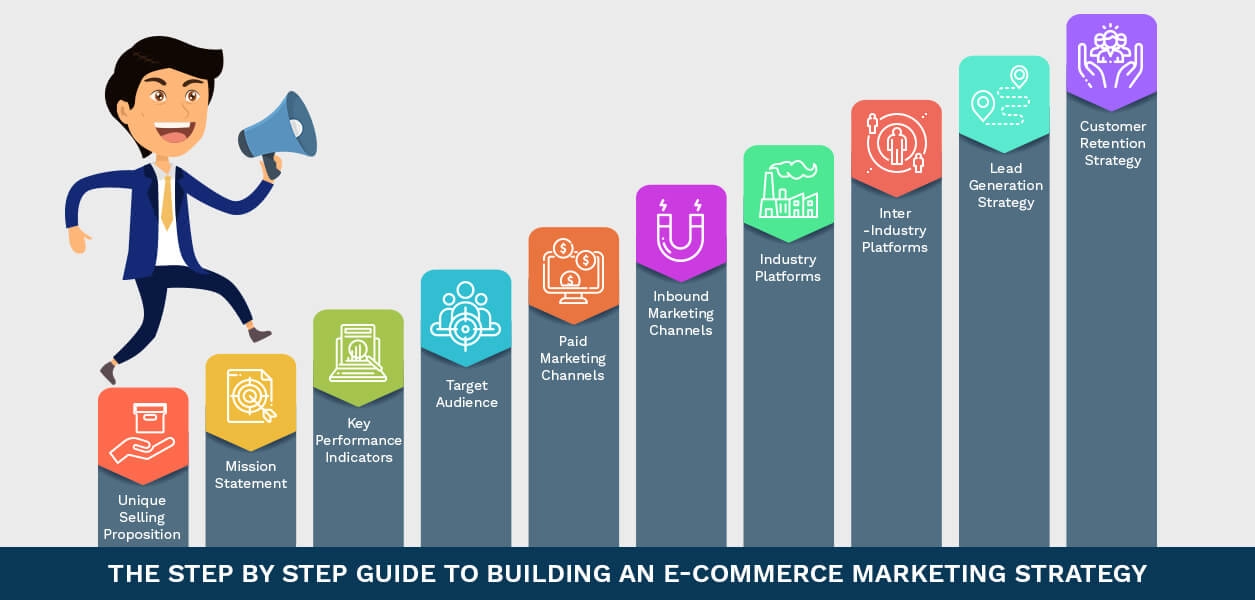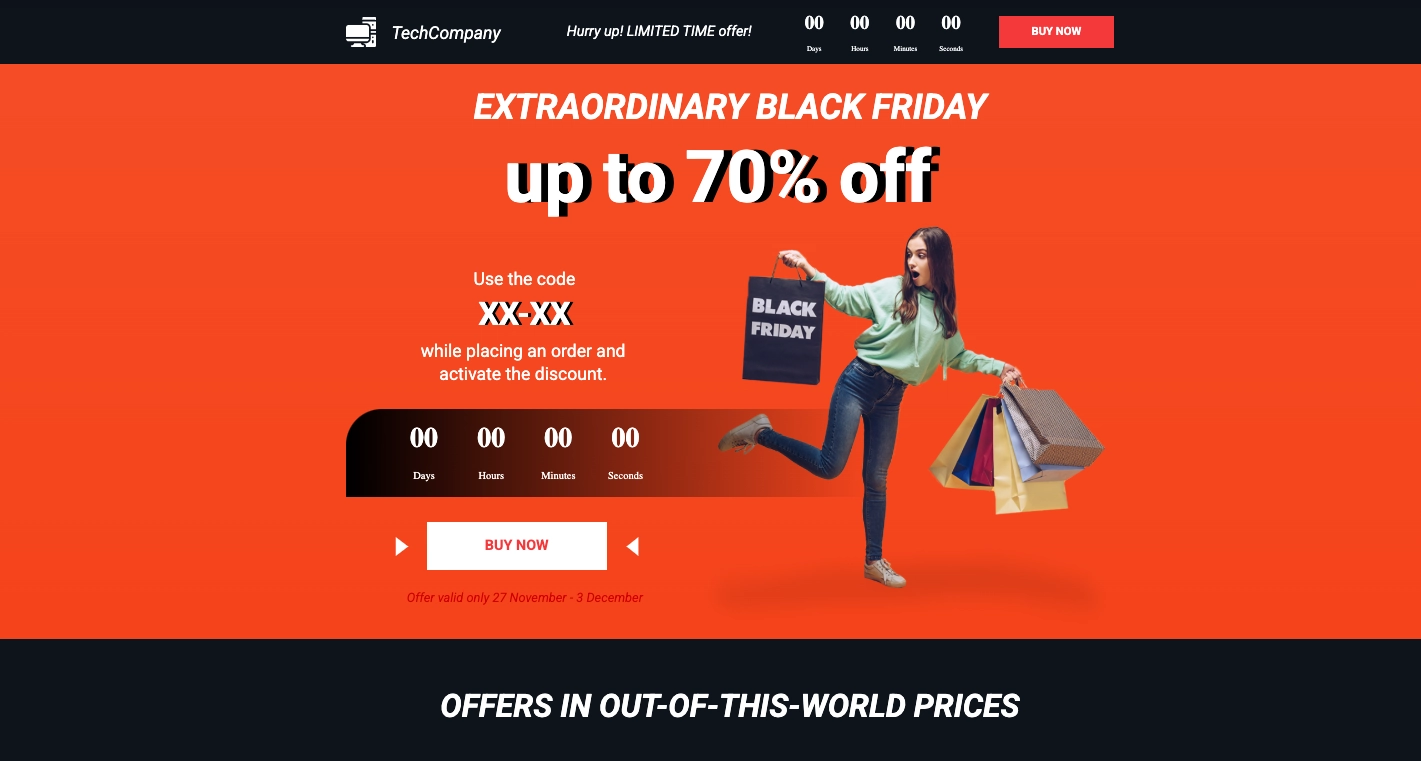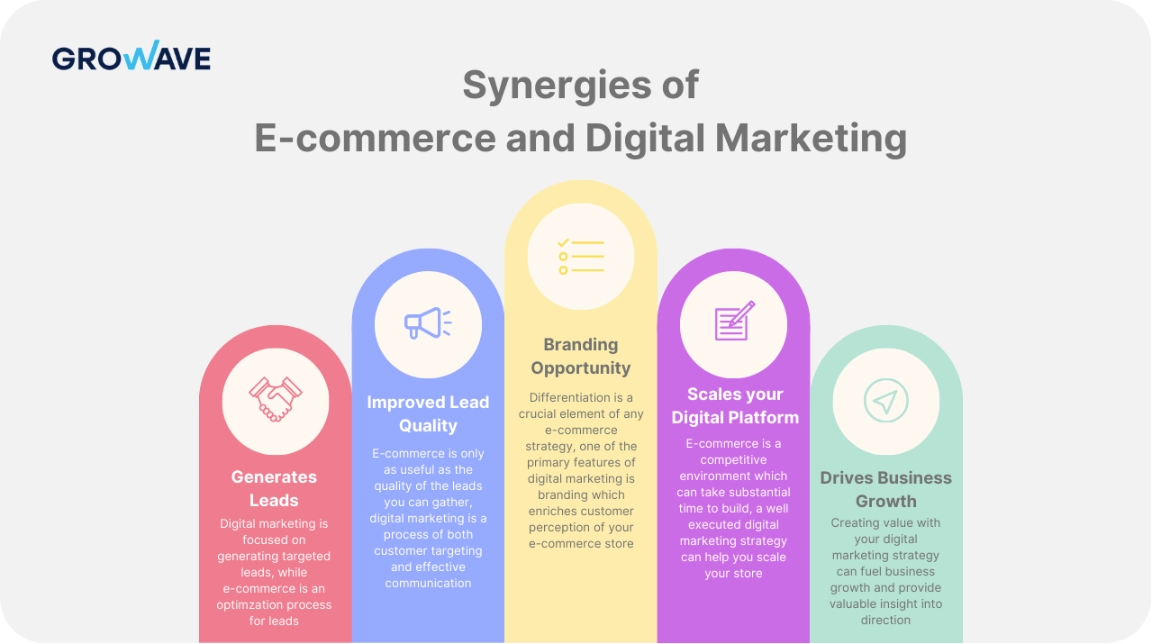Ecommerce digital marketing uses online tools and platforms to promote products, boost sales, and connect with customers. It brings together search engines, social media, email, and paid ads to build smart strategies that support growth. Well-designed landing pages are a key part of this process – they focus attention, match intent, and drive more conversions.
Retail e-commerce sales are expected to exceed 4.3 trillion U.S. dollars in 2025, according to Koen van Gelder. McKinsey also noted a 20% rise in consumers moving to ecommerce in 2020. That shift shows how vital it is to have a solid digital marketing plan.
This article explains the main elements of ecommerce marketing. You’ll find step-by-step tactics, clear tips, and real examples to help you grow.

What is Digital Marketing in Ecommerce?
Digital marketing in ecommerce means using online tools to promote products and increase online sales. It covers methods like search engine optimization (SEO), paid ads on platforms like Google and Meta, email marketing, and social media content. These tools help attract visitors, keep them interested, and turn them into buyers.
The goal is to connect with the right audience at the right time. Ecommerce businesses use data and customer insights to improve marketing decisions. They test ad performance, track user behavior, and adjust campaigns to raise sales and lower costs.
This kind of marketing helps stores grow without needing a physical location. It reaches people searching on Google, scrolling on Instagram, or checking their inbox for offers. Each step (from search to checkout) can be guided by digital strategy.
Many brands also build loyalty through post-purchase emails, rewards programs, or personalized product suggestions. These efforts boost repeat sales and increase customer lifetime value.
Online behavior keeps changing, so digital marketers must stay flexible. Testing new platforms, creative ideas, and timing strategies helps businesses stay competitive. In short, digital marketing helps ecommerce brands stay visible, relevant, and profitable in an online-first world.
Your digital marketing deserves better than bounce rates. Create landing pages that speak your customer’s language.
What is The Best Digital Marketing Strategy for Ecommerce?
The best digital marketing strategy for ecommerce builds step-by-step – starting with a strong website, then layering automation, paid ads, SEO, content, and retention. Each element should align with how your customers shop and what motivates them to buy.
Start by building a solid technical and analytics setup in month 1.
Your site must load in under 2 seconds, especially on mobile. Add an exit-intent popup offering 10% off for first-time buyers. Install Google Analytics 4 with enhanced ecommerce tracking. Structure your product categories clearly. Use heatmaps to track how users interact with your highest-earning product pages.
In months 1–2, build customer journey automation.
Set up email flows that guide new visitors toward their first purchase. A good welcome series includes:
- Email 1: Instant welcome + a 15% time-sensitive discount
- Email 2 (Day 2): Your story + bestselling products
- Email 3 (Day 4): Social proof and reviews
- Email 4 (Day 7): Product categories matched to browsing behavior
Handle abandoned carts with three emails: one after one hour (reminder), one after 24 hours (product details + reviews), and a third after 48 hours (10% discount).
Start your paid ad strategy in months 2–3.
Use Google Ads to segment by product margin. Put 60% of your budget into Shopping campaigns, and 40% into Search. Set an initial ROAS target of 3x. In Meta Ads, split your spend 70/30 between prospecting and retargeting. Use:
- Broad audience prospecting
- Look-alike audiences (1%, 3%, 5%)
- Dynamic product ads for abandoned visitors
Paid ads bring traffic—landing pages turn it into revenue. See how they complete your funnel and lift conversions.
Develop content and SEO in months 3–4.
Post two blogs weekly. Focus on:
- Product guides (40%)
- How-to content (30%)
- Industry news and updates (30%)
Target commercial keywords, like reviews, comparisons, and “best of” lists. Make sure each article answers real customer questions.
Boost social media and UGC in months 4–5.
On Instagram, post five times a week, run stories daily, and create three reels each week. A good content split is:
- Product showcases (40%)
- User-generated content (30%)
- Educational content (20%)
- Behind-the-scenes (10%)
Reply to comments within two hours to stay connected with your audience.
In months 5–6, focus on customer retention.
Build a loyalty program where each $1 spent earns 1 point. For every 100 points, customers get a $5 reward. Create three membership levels:
- Bronze: 0–500 points
- Silver: 501–1000
- Gold: 1000+
Offer unique perks at each level to encourage repeat purchases and progress.

Track and manage key performance metrics every month:
- Customer Acquisition Cost (CAC): under $30
- Return on Ad Spend (ROAS): 3x or more
- Email click-through rate: 2.5%+
- Cart abandonment rate: below 65%
- Customer Lifetime Value (CLV): 3x CAC
- Mobile conversion rate: above 2%
Keep a structured monthly optimization routine:
- Week 1: Review ad performance and adjust bids
- Week 2: Analyze feedback and update email flows
- Week 3: Run SEO audits and track competitors
- Week 4: Review all metrics and adjust strategy
Smart landing pages = better metrics. Test what works and hit your CAC, ROAS, and CLV goals faster.
Conversion rates improve when you test headlines, images, and page layouts. Look closely at where traffic comes from. Make small, consistent changes to move closer to what your audience responds to best.
This strategy is flexible. You’ll need to adjust based on your product price, how competitive your niche is, your available budget, and your customer’s age, income, or location. Timing also matters – seasonal events can drive huge spikes when the setup is right.
How to Create Digital Marketing Strategy for Ecommerce?
To create a digital marketing strategy for ecommerce, start by defining your ideal customer and the channels they use to shop or research. Use buyer personas to map out their needs, habits, and preferences. Then do market research and analyze competitors to find content gaps or positioning opportunities. This helps you choose the right mix of SEO, email, social media, and paid channels.
After that, build a content plan that matches the customer journey. Blog posts and product guides are good for early interest. Product videos, retargeting ads, and reviews work well to push purchases. Make sure all content supports search visibility and solves real questions or concerns.
Your ecommerce website should support smooth conversions. Add strong calls-to-action, simplify menus, and make sure it works well on phones. Test elements like button placement or form length to improve conversion rates.
Finally, track everything that matters. Use tools like Google Analytics to measure traffic, sales, and engagement. Let data guide your next steps. Improve what works, pause what doesn’t. A good strategy keeps changing as your store and audience grow.

5 Tips in Digital Marketing for Ecommerce
Here are five proven digital marketing tactics for ecommerce that boost sales and build stronger customer loyalty. These include abandoned cart emails, Instagram content from real customers, optimized Google Shopping feeds, high-converting landing pages, and cross-sell emails that increase repeat purchases. Each one is simple to implement and delivers measurable results.
1. Implement Abandoned Cart Email Sequences
Abandoned cart emails are one of the best ways to recover lost sales in ecommerce. Send the first email within one hour to catch customers while their interest is still high. Emails sent in that window often see a 47% open rate. This first message should remind them of their cart and include images and product details.
Send a second email about 24 hours later with a limited-time discount, usually 10% to 15%. By the third message, 72 hours after the cart was abandoned, create urgency. Phrases like “Last chance to get [product]” work well to trigger action. This three-email sequence can turn many missed sales into completed purchases.
You can also use retargeting ads to stay visible after cart abandonment. These ads keep your brand top-of-mind and can bring customers back with visual reminders across social and web platforms.
2. Use Customer Photos in Instagram Shopping
Customer photos on Instagram help ecommerce brands drive more engagement and trust than polished brand posts. User-generated content (UGC) often performs better – research shows it can lift engagement by 21%.
Ask your customers to share photos using your product, then post those images on your feed with product tags. Tags let people buy directly from the post, making the shopping process faster and easier.
Feature top UGC in Instagram Story Highlights to show real people using your products. This adds authenticity and builds credibility with future buyers. You can also run Instagram Shopping ads using your best-performing customer content to boost sales even further.
Including customer reviews next to UGC makes your posts more convincing. It gives people the social proof they need before buying.
3. Optimize Your Google Shopping Feed
A strong Google Shopping feed helps your products appear more often – and in front of the right people. Start by writing clear, keyword-rich product titles. Use this simple format: Brand + Product Type + Key Feature + Color. It improves both search visibility and customer understanding.
Your descriptions should include important search terms early and stay short but specific. Keep prices and inventory updated – Google ranks fresh listings higher. Use clear, square images with at least 800×800 resolution to show products clearly.
Add GTIN or UPC codes if available. These help Google match your products with customer searches more accurately and improve ad performance.
4. Build Product-Specific Landing Pages for Ads
Generic pages can quickly lose customers. Send ad traffic to landing pages built for the exact product being promoted. These pages should focus on one goal: getting the visitor to buy.
Keep the “Add to Cart” button easy to find – ideally above the fold. Make sure the page loads fast, especially on mobile (under 2.5 seconds is best). Add trust signals like customer reviews, shipping info, and return policies to reduce hesitation.
Use urgency where it fits, such as “Only 5 left in stock” or short-term discounts. These details encourage faster decisions and help turn more clicks into conversions.
Explore tools that help you build high-converting, mobile-first landing pages—fast.
5. Automate Post-Purchase Cross-Sell Emails
After a customer buys, follow up with product suggestions that match their original order. This keeps your brand in mind and can boost repeat sales. Send the email 5–7 days after delivery, once they’ve had time to try the product.
Use real purchase data to make smart recommendations. For example, if someone buys a camera, suggest a tripod or lens. Add a “Customers Also Bought” section and consider offering a small discount on bundles.
Include reviews for the suggested products to build trust. This kind of follow-up turns one-time buyers into repeat customers and increases your average order value.
3 Examples of Digital Marketing in Ecommerce
Digital marketing helped MVMT, Casper, and Dollar Shave Club scale fast, build brand loyalty, and drive sales. Each case shows how specific strategies (social media, content marketing, and viral video) can deliver real ecommerce growth when focused on the customer experience.
Here’s how these three ecommerce brands pulled it off.
1. MVMT Watches – Social Media Strategy
MVMT built a $100 million brand using direct-to-consumer sales and strong social media execution. The company relied on Facebook and Instagram ads and influencer campaigns to reach trend-aware younger buyers. Its visual, lifestyle-driven posts focused on minimal, stylish watch designs that resonated with the audience.
This strategy helped MVMT create a loyal community and boost word-of-mouth growth. It spent heavily on paid ads while growing organically through user-generated content. This allowed the company to bypass retail stores and still scale. That success led to a $300 million acquisition by Movado.

2. Casper Mattress – Content Marketing and SEO
Casper grew quickly by using content marketing and SEO to pull in organic website traffic. The brand created helpful blog posts around sleep health and buying advice, which helped it rank for high-value search terms. This strategy built trust with customers and answered their questions before they even considered a purchase.
By targeting search intent at every buying stage, Casper positioned itself as a reliable source – not just a mattress seller. The brand supported this with paid ads on Google and Facebook and worked with influencers to expand reach. This blend of content, SEO, and paid media helped Casper scale fast and compete with older mattress brands.

3. Dollar Shave Club – Viral Marketing
Dollar Shave Club launched with a bold, funny video that quickly went viral and drew millions of views. The 2012 ad, “Our Blades Are F***ing Great,” clearly explained the product and made people laugh – two key reasons it worked. It turned a boring product category into something fresh and worth sharing.
The company followed up with email campaigns, simple messaging, and active social media engagement. Its value pitch was clear: quality razors, low price, home delivery – no fluff. The viral video didn’t just build brand awareness; it drove real customer acquisition. This smart use of humor and direct messaging led to its $1 billion sale to Unilever.
Why is Digital Marketing Important For Ecommerce?
Digital marketing matters to ecommerce because it helps businesses reach more people and grow faster. It uses tools like search engines, email, and ads to find and connect with the right customers. SEO brings in people who are already looking for products like yours. Paid ads make sure your store shows up where it matters.
Email helps keep people interested and turns one-time buyers into repeat customers. Social media gives ecommerce brands a way to talk directly to customers and stay top-of-mind. It helps build loyalty and encourages people to share and engage.
The real power of digital marketing is in the data. You can track what works, what doesn’t, and make fast changes. That means you’re not guessing – you’re adjusting based on real customer behavior.
All of this leads to better visibility, more sales, and long-term growth for online businesses.
A landing page does more than look good—it captures intent and builds loyalty. Start today.
What’s The Use of Landing Pages in Digital Marketing for Ecommerce?
Landing pages in ecommerce digital marketing drive conversions by sending visitors to focused pages built for one goal. Instead of sending people to a homepage, you direct them to a page that matches their search or ad click.
If you’re running a Google ad for a product, that ad should take users to a landing page for that product. The page should highlight the product’s benefits, have a clear “Add to Cart” button, and include details like shipping and return policies. To increase urgency, you can show limited-time deals or low stock warnings.
That’s where Landingi stands out. It’s built for ecommerce teams who want results without getting stuck in code. With its drag-and-drop editor, ready-to-use templates, ecommerce tools, and 180+ integrations, Landingi makes building high-converting landing pages fast and simple. It’s powerful enough for pros, but easy enough for beginners – exactly what growing ecommerce brands need to move quickly and convert more.
Launch your next big sale in style with this eye-catching e-commerce landing page template. Ideal for Black Friday, flash sales, and promos that can’t wait!

What’s The Use of AI in Digital Marketing for Ecommerce?
AI helps ecommerce businesses personalize marketing, automate tasks, and improve decision-making across campaigns and platforms. It tracks customer behavior and analyzes data from browsing, clicks, and past purchases. This allows businesses to recommend products that match each shopper’s habits and preferences.
Retailers like Amazon use AI-driven recommendation engines to show products that customers are more likely to buy. This boosts conversions and builds loyalty over time.
AI also powers chatbots that respond instantly to customer questions. These bots help users find products, get support, or complete purchases – without waiting for a human agent. That speed matters. Bots reduce cart abandonment by guiding shoppers in real time and solving issues before they leave the site.
AI is also used to forecast trends by spotting changes in customer behavior or product interest. Businesses can adjust pricing or shift ad budgets based on these predictions. This lets marketers spend smarter – sending ads to the right people, at the right time, with less guesswork.
What Are The Benefits of Digital Marketing for Ecommerce?
Digital marketing benefits e-commerce businesses by increasing reach, targeting marketing, achieving measurable results, reducing costs, and fostering loyalty.
It helps online stores grow their customer base by reaching people beyond local or regional limits. With targeted advertising, businesses can focus on specific groups based on age, interests, and online behavior. This improves relevance, engagement, and sales.
You can track results in real time, using clear metrics like conversion rates, customer acquisition cost, or return on ad spend. This lets you improve your strategy based on what works best. Digital marketing also lets you control spending. You can focus your budget on proven channels like paid ads, email, or SEO.
Discover how your visitors behave—optimize like the top e-commerce brands using data, not guesses.
More than reach and cost, it helps build lasting customer relationships. You can create loyalty through personalized offers, email sequences, and influencer or affiliate partnerships.
This mix of flexibility, control, and connection makes digital marketing a key growth tool for any ecommerce brand.

What Are The Limitations of Digital Marketing for Ecommerce?
Digital marketing for ecommerce is limited by rising competition, channel overload, and shifting buyer habits.
One major challenge is the cost of paid ads. As more brands bid for attention, prices go up. This reduces profit margins and forces brands to work harder to stand out. If ad spend isn’t backed by strong targeting and creative, the return on investment drops fast.
Another issue is the pressure to manage too many platforms at once. From search to social to email, ecommerce teams often spread themselves thin. Without clear coordination across channels, the message can get lost. This confuses customers and lowers conversion rates.
Consumer behavior also changes quickly. What worked last quarter may not work now. Brands that don’t adapt in time lose relevance. This is especially true in mobile commerce, where user habits evolve rapidly.
Customer acquisition costs can also increase if marketing efforts aren’t optimized. If a brand ignores data or skips feedback loops, it risks wasting budget on the wrong audience.
Drive More Ecommerce Sales with High-Converting Landing Pages
High-converting landing pages help ecommerce stores increase sales by guiding visitors to take specific actions. They are built to reduce distractions, deliver clear value, and drive purchases faster than a general website. A targeted landing page speaks directly to one product, offer, or campaign, which makes it easier for users to decide.
To improve sales, focus on pages that match the intent of your ads, emails, or search traffic. Keep the message and design consistent from the source to the page. Use strong calls to action and limit links that pull users away from your goal. Short forms, fast load times, and mobile-friendly design also matter.
Track how users interact with your landing pages. Use that data to test and improve elements like headlines, images, and button placement. Even small changes can lead to higher conversion rates.
Want to build better landing pages without coding? Try Landingi for free. It’s a tool made for ecommerce marketers who need fast, effective results.






